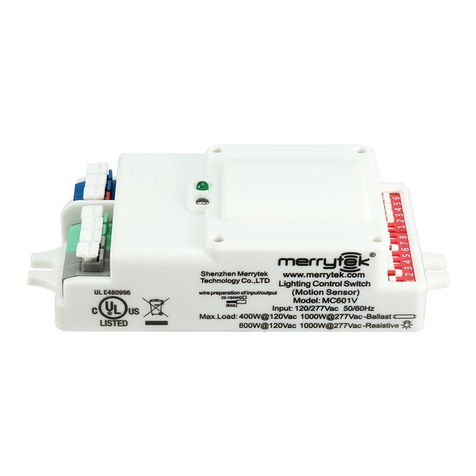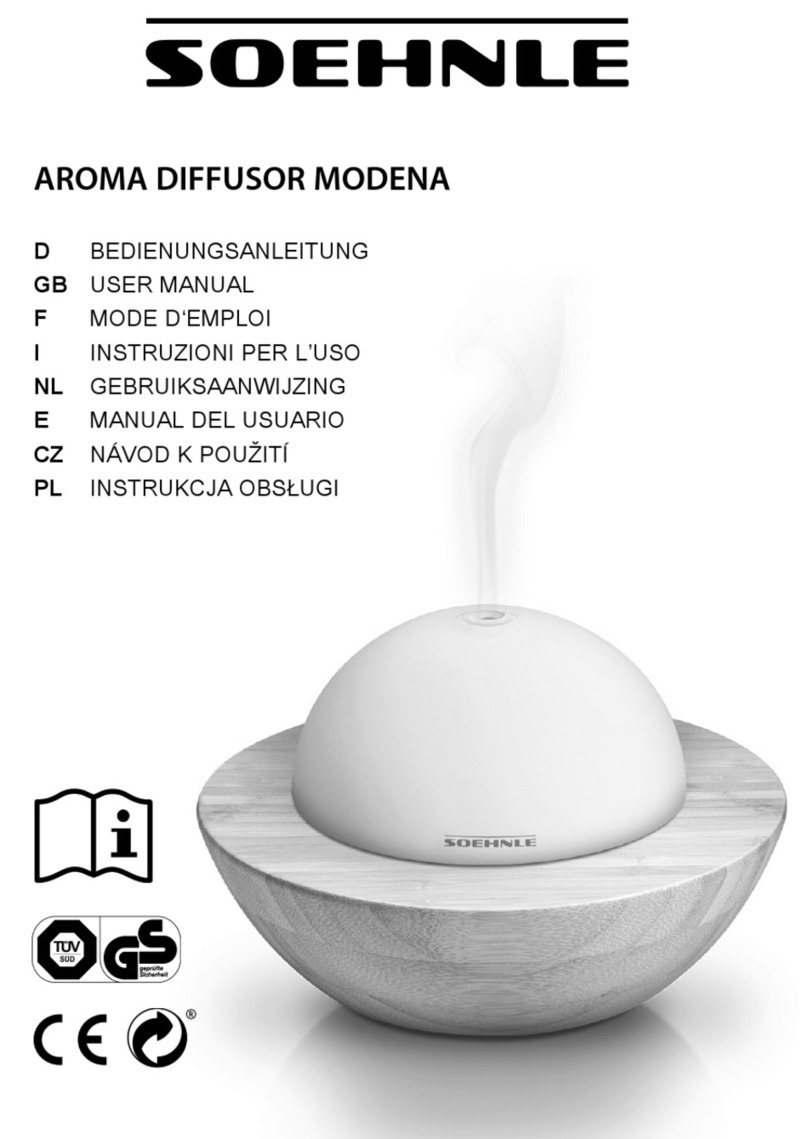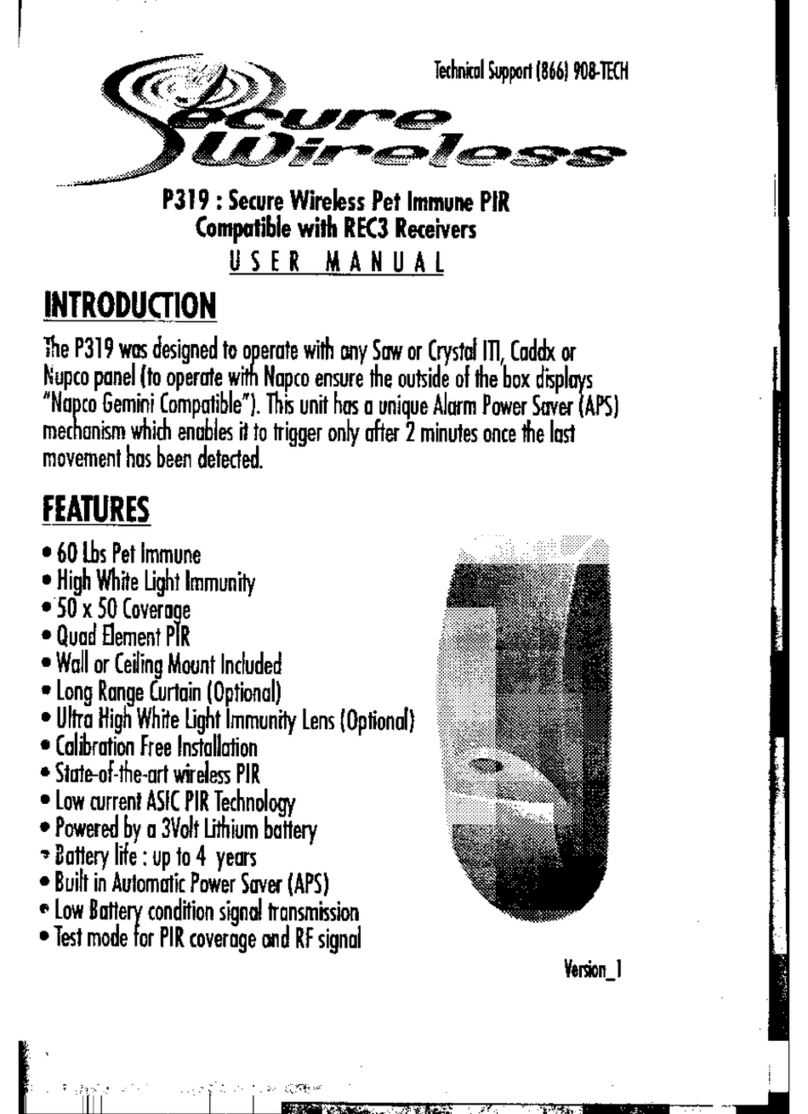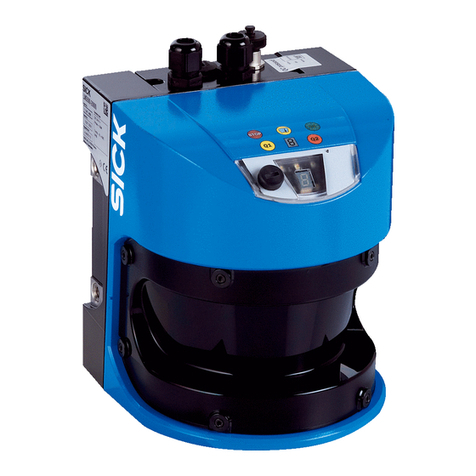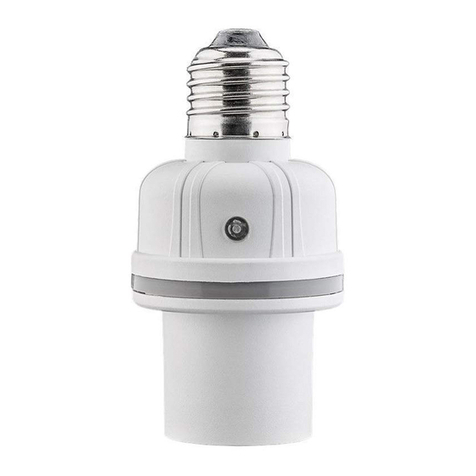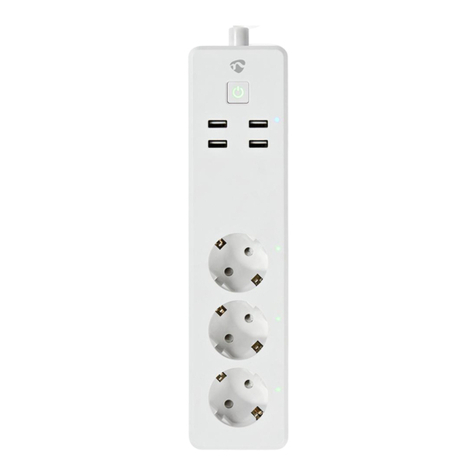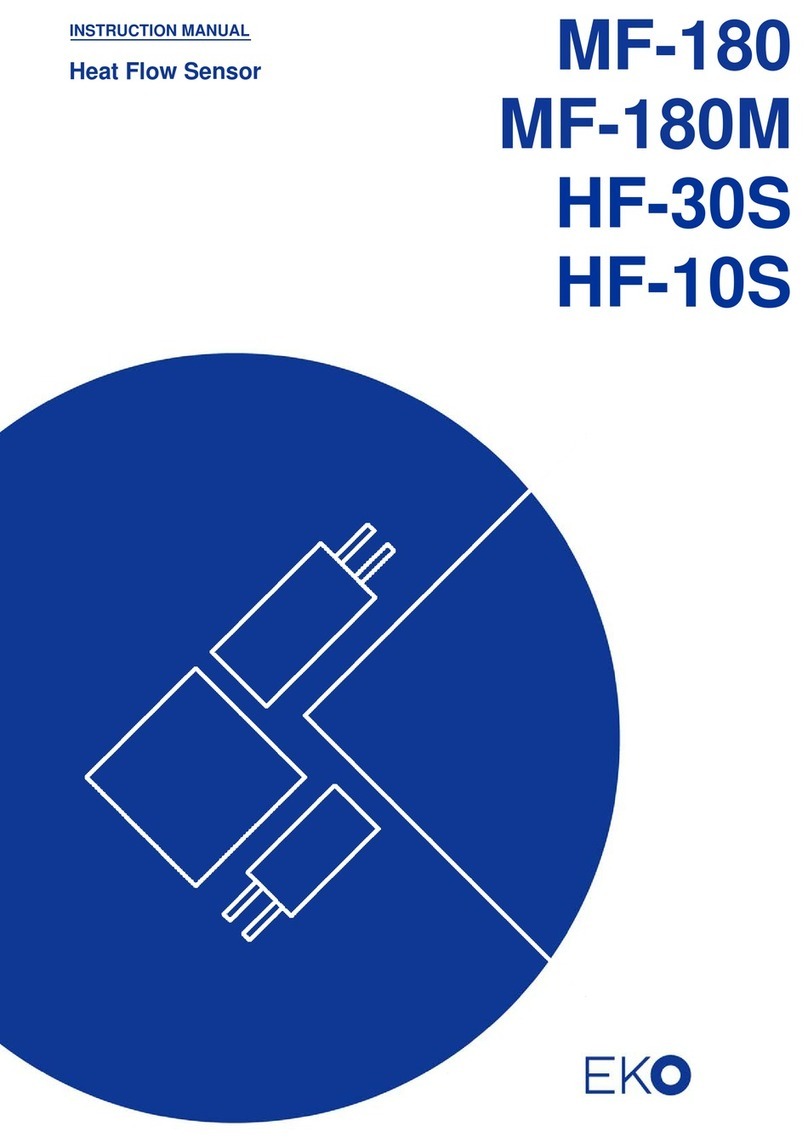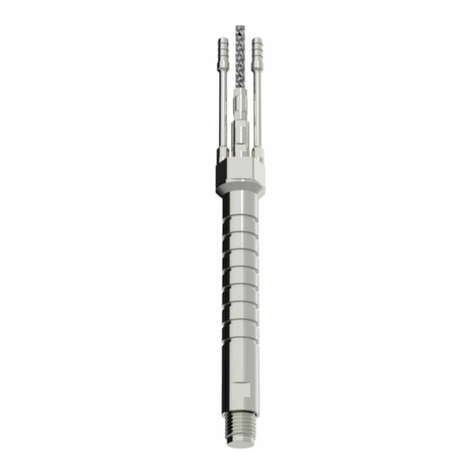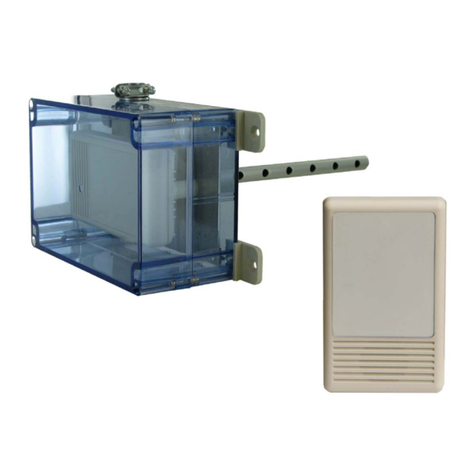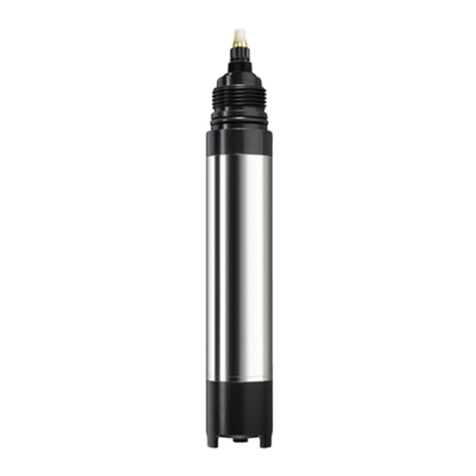SENSTAR FPS 2-2 User manual

Installation &
FPS 2-2
Fence Protection Systems
Operation Manual
G2DA0102-001, Rev A
First Edition
August 7, 2009

Senstar Corporation
119 John Cavanaugh Drive
Carp, Ontario
Canada K0A 1L0
Tel: +1 (613) 839-5572
Fax: +1 (613) 839-5830
Website: www.senstar.com
Email: info@senstar.com
G2DA0102-001, Rev A
August 7, 2009
First edition
Senstar is a registered trademark, and the Senstar logo is a trademark of Senstar Corporation. Product names and Company
names used in this manual are included for identification purposes only, and are the property of, and may be trademarks of,
their respective owners. Copyright © 2009, Senstar Corporation. All rights reserved. Printed in Canada.
The information provided in this guide has been prepared by Senstar Corporation to the best of its ability. Senstar Corporation
is not responsible for any damage or accidents that may occur due to errors or omissions in this manual. Senstar Corporation is
not liable for any damages, or incidental consequences, arising from the use of, or the inability to use, the software and
equipment described in this guide. Senstar Corporation is not responsible for any damage or accidents that may occur due to
information about items of equipment or components manufactured by other companies. Features and specifications are
subject to change without notice. Any changes or modifications to the software or equipment that are not expressly approved
by Senstar Corporation void the manufacturer’s warranty, and could void the user’s authority to operate the equipment.
Senstar’s Quality Management System is IS0 9001:2000 registered.

SENSTAR Corporation
website: www.senstar.com
email: [email protected]
INSTALLATION AND OPERATION INSTRUCTIONS
FENCE PROTECTION SYSTEMS
August 2009

Limited Warranty
a) The Company warrants that the electronic components of the products manufactured by the Company are free from all
manufacturing defects. The Company's warranty does not extend to the performance of the products, which may vary depending
on environmental conditions, use and installation practices. The Company's liability under this warranty shall be limited to, at its
option, either repairing or replacing the defective components of the products or granting a credit for the products or parts thereof.
The Company's liability shall apply only to products which are returned to the factory or authorized repair point, transportation
charges prepaid by the Buyer within one (1) year from the shipment date of the product from the Company and which are, after
examination, disclosed to Company's satisfaction to be defective due to defects in workmanship and/or materials. This warranty
shall not apply to any products which have been installed, repaired or altered by other than personnel certified by the Company, or
to products which have been subject to physical or electrical abuse, misuse, or improper storage or to products which have not
been used or maintained in compliance with any applicable recommendations of the Company. This warranty does not apply to
any parts or components of the products, which are normally consumed in operation, including but not limited to batteries, fuses
and light bulbs.
b) The Company specifically disclaims any and all warranties, expressed or implied, including but not limited to any warranties
or merchantability or fitness for a particular purpose. Under no circumstances be it due to a breach ofwarranty or any other
cause arising out of the performance or non-performance of the Product shall the Company be liable to the Buyer for incidental or
consequential damages, including but not limited to: lost profits, loss of property due to the freight, plant downtimes, or suits by
third parties.

5
INSTALLATION AND OPERATION INSTRUCTIONS — FENCE PROTECTION SYSTEMS
CONTENTS
PAGE
1 QUICK START ...................................................................... 9
2 GENERAL ...........................................................................18
3 THEORY OF OPERATION .................................................. 20
4 FENCE CONDITIONS ......................................................... 23
5 INSTALLATION .................................................................. 27
6 INITIAL SETUP AND ADJUSTMENT ................................. 57
7 SYSTEM START UP AND TESTING .................................... 63
8 MAINTENANCE/TROUBLESHOOTING ............................. 67
ADDENDUM I - FPS-2 AND FPS-EX SPECIAL INSTALLATION
PROCEDURES.................................................................. A-1

INSTALLATION AND OPERATION INSTRUCTIONS — FENCE PROTECTION SYSTEMS
6
LIST OF FIGURES PAGE
Figure 1 Typical MX-1000/5000/FPS System Conn ........ 10
Figure 2 Fence Mounted FPS Processor ............................. 11
Figure 3 Cable Tie Installation................................................ 12
Figure 4 Transducer Cable Connections ............................ 12
Figure 5 FPS Processor Wiring Connections ..................... 13
Figure 6 MPS Microwave Installation .................................. 14
Figure 7 MPS Connections ...................................................... 15
Figure 8 MX-1000/5000 Power Supply Connections..... 16
Figure 9 MX-1000/5000 Loop Connections ...................... 17
Figure 10 FPS Alarm Zone Connections ............................... 21
Figure 11 FPS Block Diagram .................................................... 22
Figure 12 Loose Fabric at Fence Posts ................................... 23
Figure 13 Loose Fabric at Diagonal Stiffeners .................... 23
Figure 14 Loose Fabric at Wire Stiffeners ............................. 24
Figure 15 Dangling Barbed Wire ............................................. 24
Figure 16 Improperly Secured Brackets................................ 24
Figure 17 Missing Vertical Locking Posts.............................. 24
Figure 18 Excessive Play ............................................................. 25
Figure 19 Loose Chain and Lock.............................................. 25
Figure 20 Roller and Rail Play ................................................... 25
Figure 21 Signs Not Securely Attached................................. 25
Figure 22 Fence-mounted Processor ..................................... 28
Figure 23 Processor Remote Mounting ................................ 30
Figure 24 Processor Pedestal Mounting ............................... 31
Figure 25 Unreeling Cable ......................................................... 32
Figure 26 Cable Tie Installation................................................ 33
Figure 27 Transducer Cable Around Fence Post ................ 34
Figure 28 Transducer Cable Service Loop ............................ 34
Figure 29 Increasing Transducer Cable Sensitivity ........... 35
Figure 30 Zone Overlap .............................................................. 36
Figure 31 Helisensor Termination ........................................... 39
Figure 32 Helisensor Installation/Termination to
NEMA Enclosure ........................................................ 40
Figure 33 Retrofit Helisensor Termination to
Standard FPS Processor .......................................... 41
Figure 34 Transducer Cable Routing in Condulet ............. 42
Figure 35 Transducer Cable Connection .............................. 42
Figure 36 End-of-Line Termination ......................................... 43

7
INSTALLATION AND OPERATION INSTRUCTIONS — FENCE PROTECTION SYSTEMS
LIST OF FIGURES .............................................................................. PAGE
Figure 37 Splice Termination .................................................... 43
Figure 38 End-of-Line Termination with 2 Megaohm
Resistor.......................................................................... 43
Figure 39 EOL Condulet attached to Fence......................... 44
Figure 40 Condulet Splice Attached to Fence .................... 44
Figure 41 Condulet“G”Attached to Fence .......................... 44
Figure 42 Transducer Service Kit ............................................. 46
Figure 43 Transducer Cable Preparation .............................. 46
Figure 44 Hinged Gate Installation......................................... 47
Figure 45 Telegate Installation ................................................. 48
Figure 46 Telegate Support Post Location........................... 49
Figure 47 MPS Microwave System .......................................... 51
Figure 48 Transducer Cable Connection .............................. 52
Figure 49 FPS-2-2M Wiring Connections.............................. 54
Figure 50 FPS-2-2R Wiring Connections ............................... 55
Figure 51 Relay Jumper Options ............................................. 56
Figure 52 Processor Adjustments ........................................... 57
Figure 53 FPS Main Board Jumper Settings ........................ 59
Figure 54 Revision F Transponder Board .............................. 60
Figure 55 Revision G Transponder Board ............................. 61
Addendum Figures:
Figure A-1 FPS-2 Connections.................................................. A-3
Figure A-2 FPS-EX Connections ............................................... A-4
LIST OF TABLES
Table 1 FPS Features ................................................................ 19
Table 2 Sensor Cable Capacitance...................................... 22
Table 3 FPS-2-2(*) Troubleshooting Table........................ 70
Table 4 FPS-2-2(*) Voltage Measurements ...................... 71
Addendum:
Table A-1 Troubleshooting Measurement Chart ............. A-5

INSTALLATION AND OPERATION INSTRUCTIONS — FENCE PROTECTION SYSTEMS
8
This page intentionally left blank.

9
INSTALLATION AND OPERATION INSTRUCTIONS — FENCE PROTECTION SYSTEMS
FENCE PROTECTION SYSTEMS
1 QUICK START
Qualified technicians may follow these simplified procedures to install and test the typical MX-1000/
5000/ Fence Protection System, including installation of the MX-1000/5000, FPS-2-2M fence protection,
and MPS microwave system. Prerequisites for using the quick start procedures are:
• Attendance at one or more Senstar MX-1000/5000/ training class.
• Prior MX-1000/5000 field installation experience.
Before proceeding, VERIFY that you have a complete site layout showing zone extents, processor
locations, and conduit interconnections. If you are not familiar with any of the procedures described in
this section, refer to the appropriate manual for more detailed information.
NOTE: If you are installing a G-Line system, please contact the factory for additional
instructions.
IMPORTANT PROCEDURES
Throughout the installation it is very important that certain procedures are observed:
Install ground rods and proper grounding at the MX-1000/5000, all FPS proces-
sors, and all microwave locations.
Use only the approved multiconductor shielded cable for connecting the MX-
1000/5000 to the FPS and MPS units.
Terminate wiring and shields exactly as shown. Improper terminations will cause
system noise and degrade performance.

INSTALLATION AND OPERATION INSTRUCTIONS — FENCE PROTECTION SYSTEMS
10
Installation
Figure 1 shows the typical wiring interconnection of components.
• The interconnect wiring should be run in conduit, either underground or along the base of the
fence.
• The interconnect cable must be an approved three-pair, 18-gauge, individually shielded twisted
pair cable, with overall foil shield, braid shield, and high density polyethylene jacket, such as the
Senstar Interconnect Cable or factory-approved equal.
Figure 1. Typical MX-1000/5000 / FPS System Connections

11
INSTALLATION AND OPERATION INSTRUCTIONS — FENCE PROTECTION SYSTEMS
Mount each FPS processor as shown in Figure 2.
• Use metal brackets or Unistrut-type mounting material to provide a solid backing. A fence post
will provide a solid mounting.
• Arrange the conduit/control wiring entrance as shown.
• Install a copper-clad ground rod at each processor location, and connect a minimum 8-gauge
ground wire to the processor bolt as shown. IMPORTANT: Connect the ground wire directly to
the processor bolt as shown.
Figure 2. Fence Mounted FPS Processor

INSTALLATION AND OPERATION INSTRUCTIONS — FENCE PROTECTION SYSTEMS
12
Run the sensor cable from each FPS processor as shown in Figures 2 and 3.
NOTE: Your installation may utilize either standard "black" sensor cable or Helisensor.
Observe special requirements for each type sensor.
• Attach the sensor cable to the
fence at approximate 12-inch
intervals with black UV cable ties
as shown in Figure 3. Use ONLY
the approved black UV-pro-
tected cable ties.
• Provide service loops every 50
feet and increased sensitivity
loops at each corner or end post.
Provide cable overlap at adjacent
zones. Install TSK termination
boxes at each sensor end-of-line
and splices if necessary.
• Connect each sensor cable to the
processor as shown in Figure 4.
Figure 3. Cable Tie Installation
Figure 4. Transducer Cable Connections

13
INSTALLATION AND OPERATION INSTRUCTIONS — FENCE PROTECTION SYSTEMS
Connect the control wiring to each processor as shown in Figure 5.
• Verify that all shields are connected as shown. Keep the shields separate as shown. DO NOT
connect the individual cable shields to one another.
• Install a short wire jumper between terminals 1 and 3.
• Set the correct transmit and receive address for each processor. Refer to the MX-1000/5000
manual,Table 5, for processor switch settings.
Figure 5. FPS Processor Wiring Connections

INSTALLATION AND OPERATION INSTRUCTIONS — FENCE PROTECTION SYSTEMS
14
Mount each MPS microwave unit (pair) as shown in
Figure 6. Note that the installation includes the
microwave pair and the stand-alone transponder.
• Install each piece of equipment generally as
shown.
• Run interconnecting cables and connect as shown in
Figure 7.
Position the MX-1000/5000 Control Unit in the control room
as appropriate for proper viewing and operation. Connec-
tions will be made to the MX-1000/5000 rear panel as shown
in Figure 1.
Figure 6. MPS Microwave Installation

15
INSTALLATION AND OPERATION INSTRUCTIONS — FENCE PROTECTION SYSTEMS
Figure 7. MPS-4100TR Host Receiver Connections to MX-1000/5000

INSTALLATION AND OPERATION INSTRUCTIONS — FENCE PROTECTION SYSTEMS
16
Connect the power supply transformer and battery as shown in Figure 8.
• Connect the transponder loop cable as shown in Figure 9. Perform the connections for each
transponder loop connected to your system.
• Connect the ribbon cable for the Map Interface and Relay/Mobile Map/RANS interface as shown.
Apply power to the MX-1000/5000 by connecting the AC power first, then the battery system. Perform
initial programming to acknowledge initial alarms.
Measure voltage at the end processor. Record voltage and adjust MX-1000/5000 voltage to bring end-
of-loop processor to 12 VDC. Check the voltage at each other processor starting with the unit closest
to the MX-1000/5000. Add resistors at each processor where needed to provide correct processor
operating voltage.
Complete MX-1000/5000 programming by performing the programming steps needed for your
system. For programming reference, refer to MX-1000/5000 Installation Manual,Table 4.
Perform initial testing of each zone, and perform fence quieting procedure if necessary. Adjust the
count and gain switches in each processor to provide required climb and cut detection.
Perform final testing, including climb test, in each zone as required by the system specifications.
Figure 8. MX-1000/5000 Power Supply Connections

17
INSTALLATION AND OPERATION INSTRUCTIONS — FENCE PROTECTION SYSTEMS
Figure 9. MX-1000/5000 Loop Connections

INSTALLATION AND OPERATION INSTRUCTIONS — FENCE PROTECTION SYSTEMS
18
2 GENERAL
Senstar manufactures a unique outdoor perimeter intrusion detection system called the Fence
Protection System (FPS).The basic FPS system consists of a Fence Mounted Transducer Sensor Cable,
and the Signal Processor Unit. The FPS system is designed to be easily installed on chain link fences
and will detect someone attempting to climb, lift the fence fabric, or cut through the fence.When the
transducer cable is installed on the fence, the transducer cable AND THE FENCE become the fence
protection sensor system.
This manual covers all FPS system installations that utilize the coaxial sensor cable. Individual FPS
systems have special features that are tailored to specific applications. The following is a brief descrip-
tion of the features of each model. Refer to Table 1 for a list of unique features for each model.
Model Description
FPS-EX Single zone alarm processor for smaller installations
FPS-EXH Single zone alarm processor for use with Helisensor armored cable
FPS-2 Single zone processor manufactured to military specifications with TNC sensor
cable connector and Mil-Spec control wiring connector.
FPS-2H FPS-2 single zone processor for use with Helisensor armored cable
FPS-2-2R Two zone alarm processor with relay contacts for alarm and tamper outputs
FPS-2-2RH FPS-2-2R two zone alarm processor for use with Helisensor armored cable
FPS-2-2M Two zone alarm processor for use with MX-1000/5000 Comgard Multiplex Commu-
nications System
FPS-2-2MH FPS-2-2M two zone alarm processor for use with Helisensor armored cable
FPS-2-2M/AP Two zone alarm processor for use with EDAPT intelligent alarm processing system
FPS-2-2MH/AP FPS-2-2M/AP two zone alarm processor for use with Helisensor armored cable
FPS-2-2M/FOC Two zone alarm processor for use with fiber optic communication system
Senstar FPS systems can be used individually or combined with several FPS units and an alarm
control system and accessories, providing the fence protection for the complete facility perimeter.
This manual covers the installation of all of the above listed FPS systems with the exception of the
fiber-optic communication system. The differences between units are generally the type of sensor
cable utilized, standard or Helisensor, and the type of alarm output type, relay fiber, or MX-1000/5000
multiplex. During the installation procedures, individual procedures are identified for each type
system where required.

19
INSTALLATION AND OPERATION INSTRUCTIONS — FENCE PROTECTION SYSTEMS
Table 1. FPS Features
FPS-EX ✔ ✔ ✔✔ ✔ ✔✔✔✔✔✔✔✔ 1 Zone Cost effective
FPS-EXH ✔ ✔ ✔✔ ✔ ✔✔✔✔✔✔✔✔ 1 Zone Cost effective
FPS-2 ✔ ✔✔✔ ✔✔✔✔✔✔✔✔ 1 Zone Mil Spec Connector
FPS-2H ✔ ✔✔ ✔✔✔ ✔✔✔✔✔✔✔✔ 1 Zone Mil Spec Connector
FPS-2-2R ✔✔ ✔✔ ✔ ✔ ✔✔✔✔✔✔✔✔ Dual Zone Unit/less wires
FPS-2-2RH ✔✔ ✔ ✔ ✔ ✔ ✔✔✔✔✔✔✔✔ Dual Zone Unit/less wires
FPS-2-2M ✔✔ ✔✔ ✔ ✔✔ ✔✔✔✔✔✔✔ Multiplex Comm. on 6 conductor wire
FPS-2-2MH ✔✔ ✔ ✔ ✔ ✔✔ ✔✔✔✔✔✔✔ Multiplex Comm. on 6 conductor wire
FPS-2-2MH/AP ✔✔ ✔ ✔ ✔ ✔✔ ✔✔✔ ✔✔✔ EDAPT Processing at MX
FPS-2-2M/AP ✔✔ ✔✔ ✔ ✔✔ ✔✔✔ ✔✔✔ EDAPT Processing at MX
FPS-2-2MFO ✔✔✔ ✔ ✔ ✔✔ ✔✔✔ ✔✔✔ EDAPT Processing at MX
Cast Aluminum Enclosure
All Openings gasketed and sealed
Sensitivity Adjustments
Internal count adjustments
Lightning Protection
Audio assessment
Self Test
Programmable Relay output
Multiplex Output
Removable Terminal Blocks
19 Pin Connector
Tamper
Single Zone
Dual Zone
MEX Cable
MB Cable
Helisensor
Fiber Optic Communication
EOL Furnished Cable Ties Supplied
Plug In Boards

INSTALLATION AND OPERATION INSTRUCTIONS — FENCE PROTECTION SYSTEMS
20
3 THEORY OF OPERATION
Concept
When the Transducer Sensor Cable experiences small mechanical shocks or vibrations, an electrical
signal is generated between the center conductor and the outer shield.The Signal Processor then
analyzes that signal and makes the determination as to whether the vibration is intruder related or
from natural causes such as wind, rain, hail, etc. Should there be an intruder, the signal processor will
generate an alarm output.
There are two types of alarm processing methods available: Standard and EDAPT. The standard system
processes alarm information based on individual settings programmed at each processor.The EDAPT
system utilizes a computer modeling program to analyze the fence activity of each alarm zone and
automatically adjust the alarm threshold based on current fence conditions and historical data.
Alarm processing
The Senstar FPS system is a strain-sensitive cable sensor system, meaning that a mechanical disturbance in
the fence causes a small strain on the sensor cable that is converted to an electrical signal.
The sensor cable is a small coaxial cable specially manufactured with a permanent electrical charge
throughout its entire length. Any movement in the fence causes a small voltage to appear at the
sensor cable output. Senstar tests every foot of the sensor cable to verify that the alarm sensitiv-
ity will be uniform over the entire length.
The sensor cable connects to the FPS processor mounted on or near the fence at the beginning of the
detection zone.The mechanical disturbance detected by the sensor cable is sent to the FPS Processor.
Each FPS-2-2 processor contains two independent zones of perimeter protection (see Figure 10).The
typical FPS-2-2 will have up to a 1000-foot alarm zone running in each direction from the processor
unit.The standard processor circuitry analyzes the disturbance detected by the sensor cable (see
Figure 11).The electronics are designed to match the characteristics of the sensor cable and only
report as alarms those signals that are similar to the disturbances caused by climbing, cutting, or lifting
the fence fabric.
The EDAPT advanced processor sends alarm data to the MX-1000/5000 communications and Control
System for additional processing. The EDAPT advanced processor MX-1000/5000 Control System is
capable of storing and analyzing each zone’s alarm data over time. The alarm data is used in a unique
calculation to best determine the occurrence of an actual alarm condition over the external physical
forces (wind, rain, etc.), and the aging conditions of the fence installation.
The detected alarm signals are sent by the processor to the alarm monitoring and control point. Alarm
monitoring can be accomplished in a number of ways. Senstar recommends the MX-1000/5000 Communi-
cation and Control Center, which uses the exclusive CEnDe multiplex alarm communications system,
reporting up to 60 alarm zones. The EDAPT system must operate with an EDAPT advanced processor
MX-1000/5000 Control Center and the CEnDe communications system. Senstar also manufactures the FPS-
2-2R processor, containing both alarm and tamper relay outputs, for interfacing to monitoring equip-
ment by other manufacturers.
This manual suits for next models
1
Table of contents
Other SENSTAR Accessories manuals
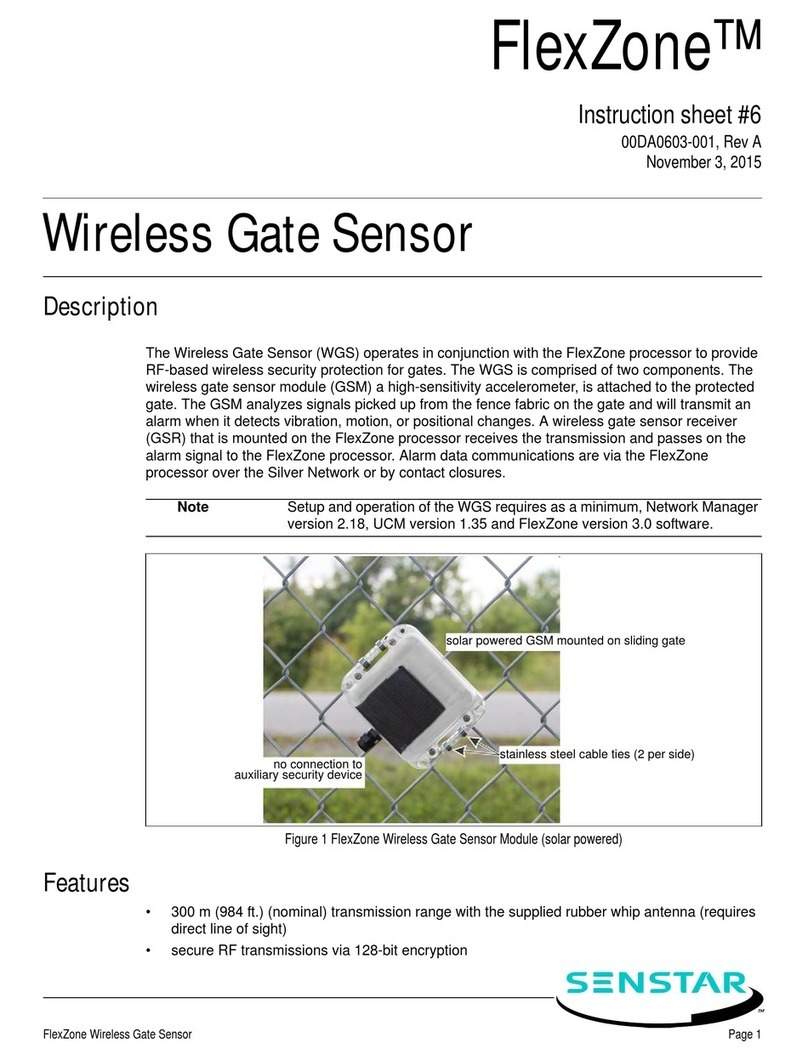
SENSTAR
SENSTAR FlexZone WGS User manual

SENSTAR
SENSTAR UltraWave BR100 User manual

SENSTAR
SENSTAR FiberPatrol FP400 User manual

SENSTAR
SENSTAR IntelliFIBER User manual
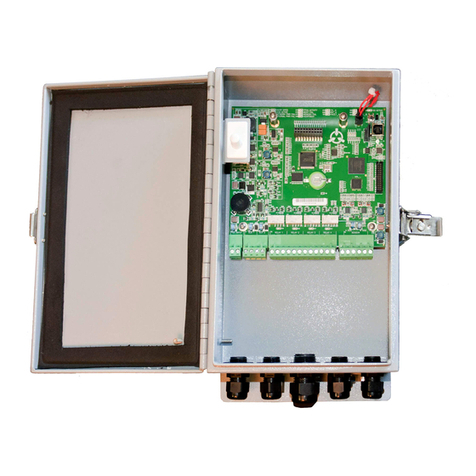
SENSTAR
SENSTAR FlexZone User manual
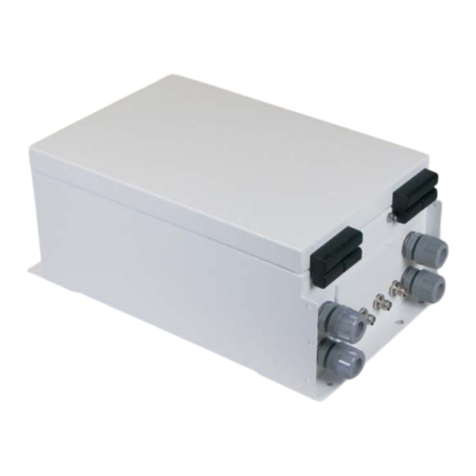
SENSTAR
SENSTAR OmniTrax User manual
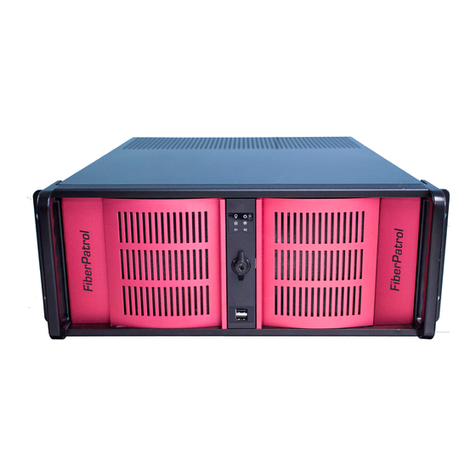
SENSTAR
SENSTAR FiberPatrol FP1150 Series User manual
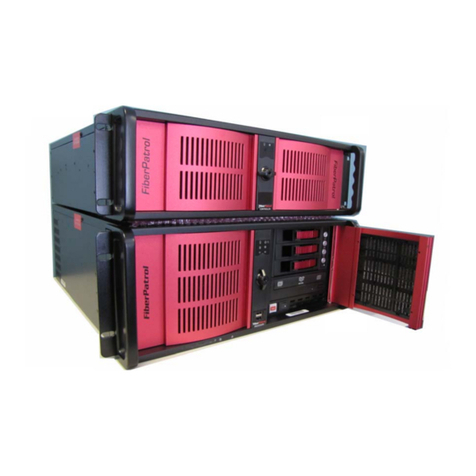
SENSTAR
SENSTAR FiberPatrol FP1100X Series Technical manual
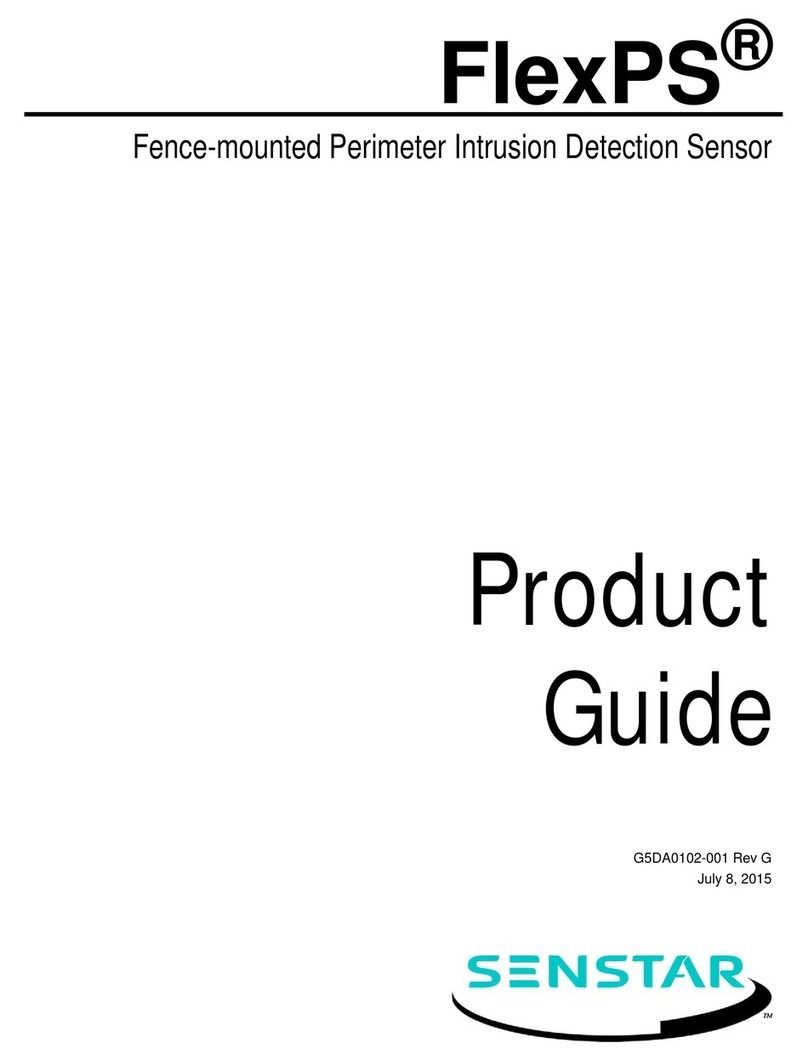
SENSTAR
SENSTAR FlexPS User manual
